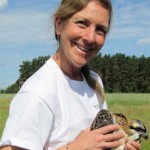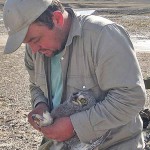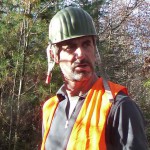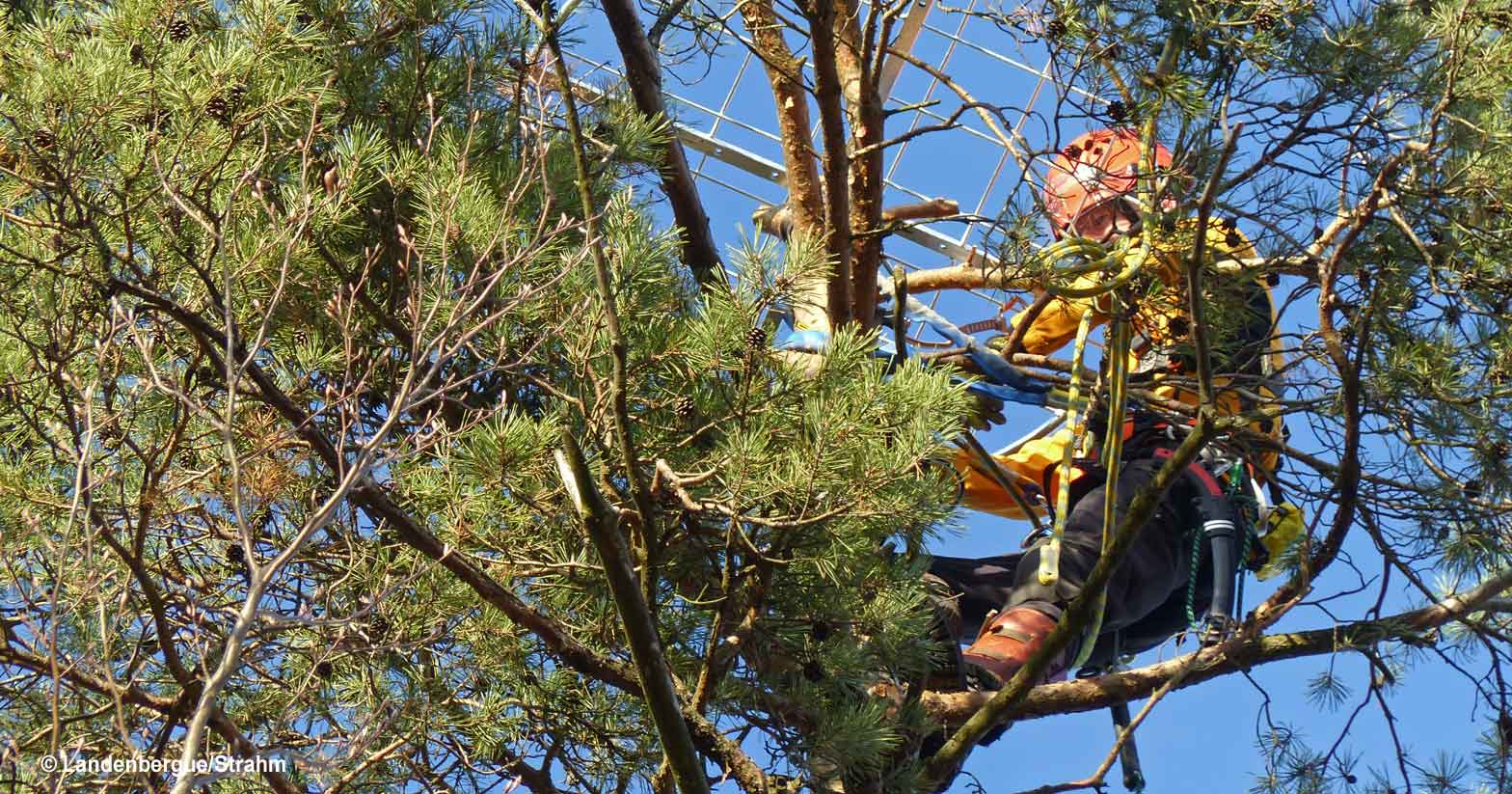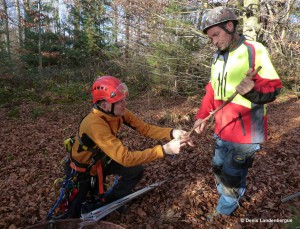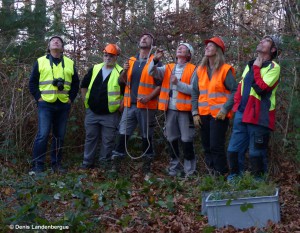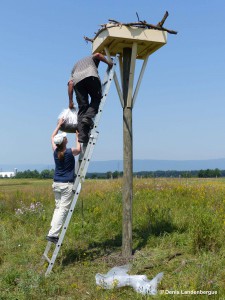Whether it was chopping fish, watching and guarding the young ospreys, fixing radio transmitters, building nests, or many other tasks (not least of all fish tossing), to all the 2015 team we give a very big thank you!
Our first artificial nests

An important part of our Osprey reintroduction project consists of building artificial nests to give the birds a helping hand when they return to Switzerland to breed. Once we had identified potentially suitable trees and obtained permission to build nests in their tree tops, Daniel Schmidt (pictured in action above) came from Germany to demonstrate and provide training in the art of building artificial nests that no Osprey would be able to refuse. Three Fribourg ornithologists who are also very experienced tree-climbers (Christian Grand, Pascal Grand and Henri Vigneau) helped Daniel to build the first nest, and then went on to build a second nest the following day. Michel Beaud, Emile Curty, Denis Landenbergue and Wendy Strahm also helped out in this operation.
Osprey nests are usually built on a tall tree with commanding views, so the birds can have a panoramic 360° view. Our first two nests were built at the top of 35m tall Scots Pines, a difficult operation so we were lucky to have good weather with little wind. It will probably take several years before our released birds return, and we are optimistic that when they do, they will find these custom-made platforms irresistible. Many thanks to the whole team for these first two beautiful nests, and for the many more that we are already planning on building.
PP5 escapes for the third time

After “escaping” from the prison grounds of Bellechasse when departing on migration on September 11, and then narrowly escaping death after being shot in Algeria by a poacher on September 16, PP5 has once again demonstrated his amazing capacity for escape. On October 11 Toufik Brahimi, the veterinarian who saved his life, went to examine and weigh him in preparation for his release planned for a few days later. PP5, however, had other ideas. After biting Mr Brahimi’s hand with his strong beak, he took advantage of the moment to push the door of the aviary open and to escape, immediately flying high above the mountains of Djurdjura until he was out of sight. While we had imagined a more controlled release back into the wild, we are reassured by Mr Brahimi who says that the bird had completely recovered from his wounds, had eaten well just before his escape, and was very dynamic. So dynamic in fact that he was not willing to spend any longer in captivity.
 We will only know if PP5 has survived his ordeal if he returns to Switzerland in a few years’ time. However, as his blue plastic ring marked PP5 was damaged and had to be removed, he will be more difficult to identify. Indeed, this plastic ring may have saved PP5’s leg from being injured, as it was presumably damaged in the shooting. If we ever see a male Osprey with just a metal ring on his left leg returning to our release site it could well be our escape artist.
We will only know if PP5 has survived his ordeal if he returns to Switzerland in a few years’ time. However, as his blue plastic ring marked PP5 was damaged and had to be removed, he will be more difficult to identify. Indeed, this plastic ring may have saved PP5’s leg from being injured, as it was presumably damaged in the shooting. If we ever see a male Osprey with just a metal ring on his left leg returning to our release site it could well be our escape artist.Great news from Portugal

It has just been reported that a pair of Ospreys nested for the first time this year in the Alqueva reservoir, site of the Portuguese Osprey reintroduction project. However, it seems that the birds nested just across the border in the Extremadura region of Spain! The nest was spotted from a boat by Dr Luis Palma on July 19th, but the interior of the nest couldn’t be seen, and no birds were observed in the vicinity. However, Spanish wildlife guard Nicolás Durán and Isabel Asensio saw a pair accompanied by a juvenile on 30 August, indicating that the Portuguese reintroduction project has had its first success. The reintroduction of this species at the Alqueva Reservoir started in 2011 and is still ongoing. Congratulations to our Portuguese colleagues and friends for this wonderful result!
PP5 in Algeria
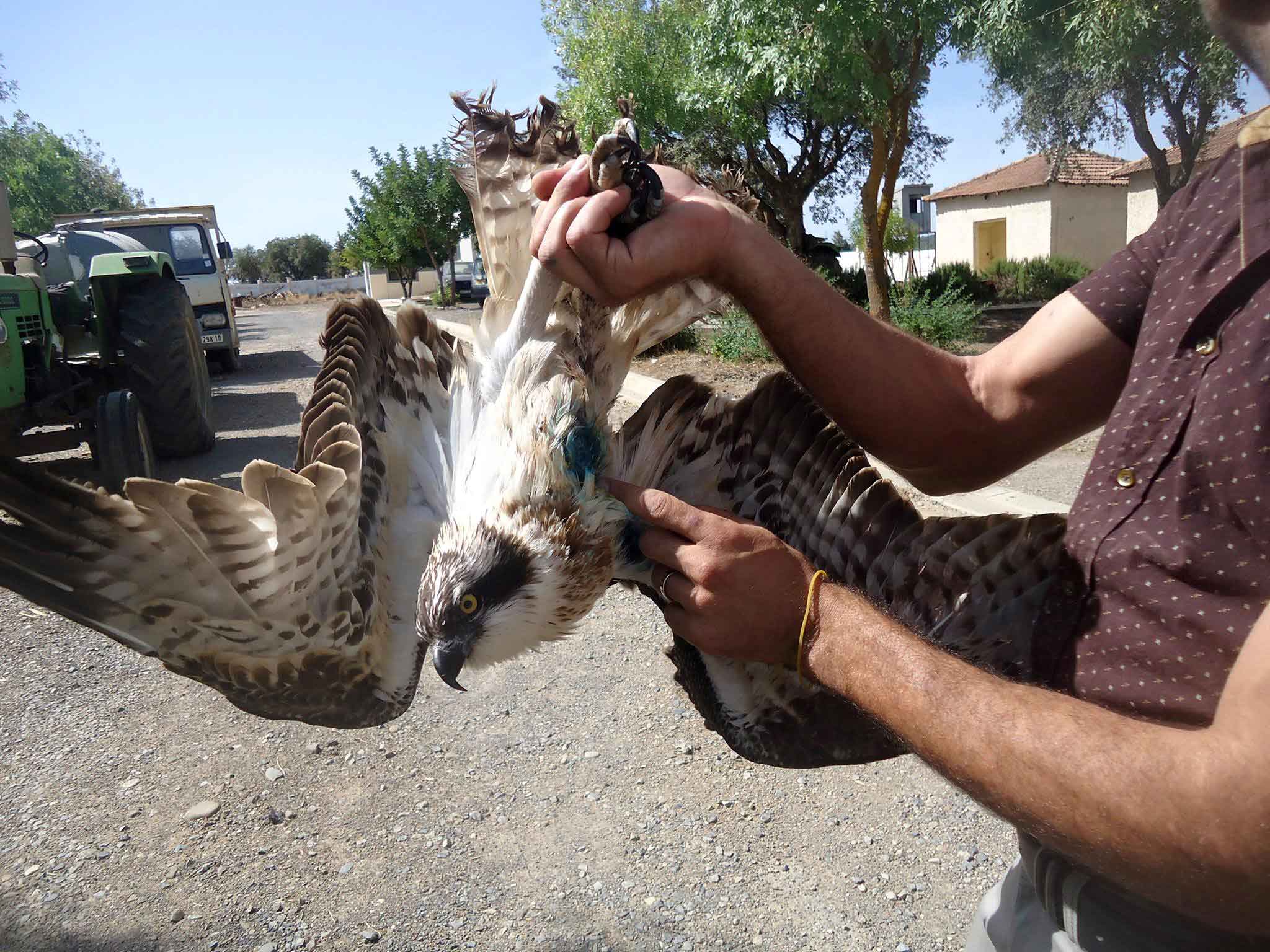 We recently received some shocking news from Algeria concerning one of our young ospreys called PP5 (nicknamed “Chernobyl” due to the markings on the back of his head which resemble a radiation symbol). This male had been found shot by a poacher in the region of the Djurdjura National Park, about 100 km east of the capital city Algiers.
We recently received some shocking news from Algeria concerning one of our young ospreys called PP5 (nicknamed “Chernobyl” due to the markings on the back of his head which resemble a radiation symbol). This male had been found shot by a poacher in the region of the Djurdjura National Park, about 100 km east of the capital city Algiers.
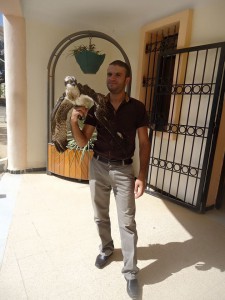
The good news is that he is alive, thanks to the Park’s veterinarian Mr Toufik Brahimi, who operated on him and removed two shotgun pellets from his chest and the base of his wing. Mr Brahimi then contacted the Swiss Ornithological Station at Sempach, based on the inscription marked on his ring. We are now in direct contact with Mr Brahimi to discuss the best way to take care of PP5. He is fed daily with fresh fish and the latest news indicates that he seems to be on the road to recovery. Note that PP5 had left the Swiss reintroduction site on September 11, and had the misfortune to be shot on the 16th, exactly 5 days after his departure and some 1,200 km away after crossing the Mediterranean Sea.
It is not yet possible to know if PP5 will make a full recovery from his terrible ordeal although we are hopeful. Coincidentally Mr Brahimi remembered meeting us (Denis Landenbergue and Wendy Strahm) when we visited the National Park of Djurdjura in 2008. One additional reason for him, as if it were needed, to do his best to save what he refers to as “our bird”.
It is well known that only a third of young Ospreys usually survive to adulthood. There are many possible causes of loss: natural predation, ocean gales, sand storms, collisions with vehicles, wires or electrical lines, poaching or shooting through ignorance, etc.
Our last two Ospreys have left
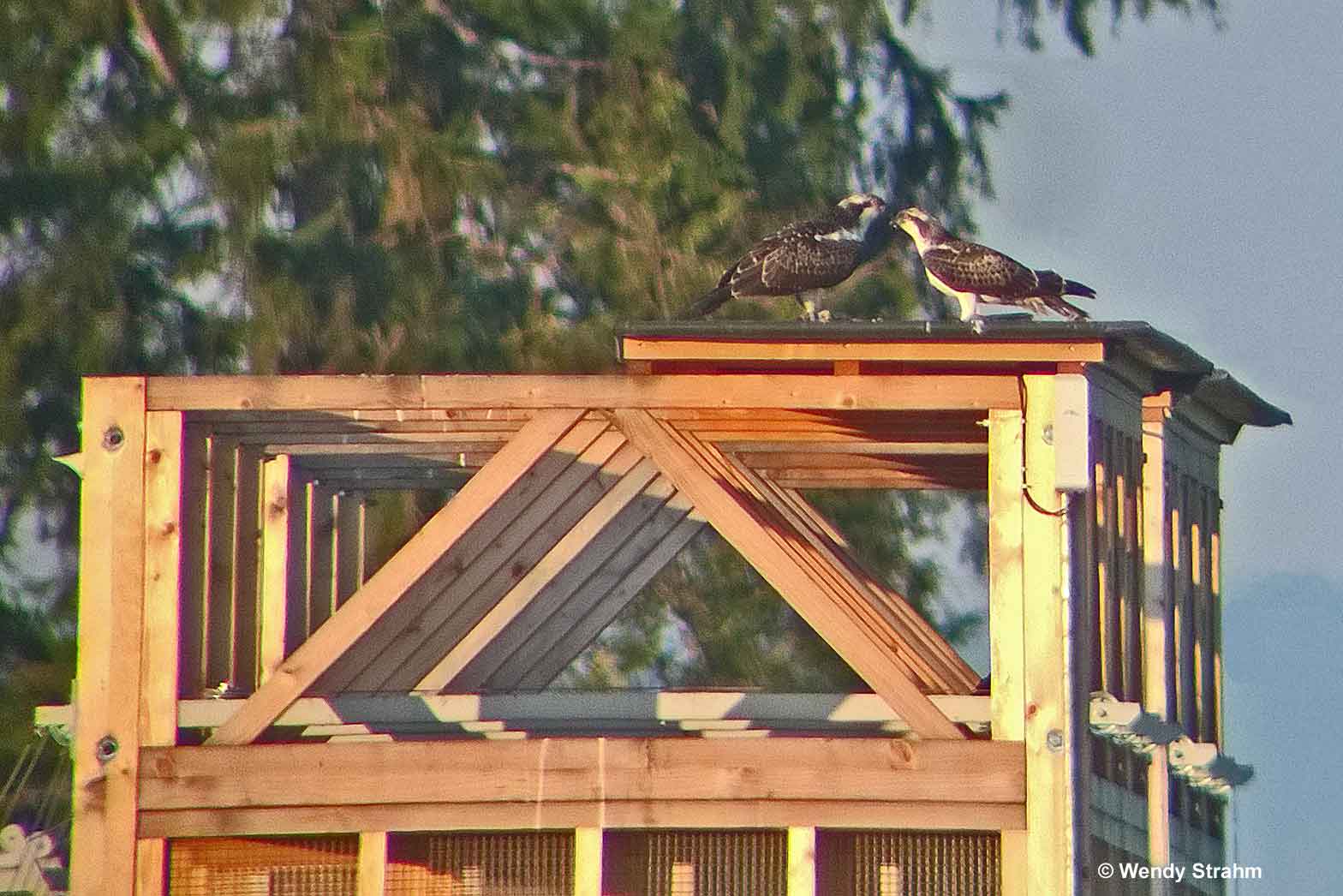 On September 19, our last two young Ospreys of the 2015 reintroduction season left for Africa. The project team were watching PP1 and PP4 (named after the code on their colour ring) when the female suddenly spiralled high into the sky before heading south. A few hours later PP4 did the same. The photo above shows the difference in size between PP1, the female (to the left), and PP4, the male, on top of their release aviary. Since September 19 we waited several days to be absolutely sure that they had really left. It is common that young ospreys first make a “false departure”, which might last up to 2 or 3 days, before returning to the reintroduction site for more food before they finally decide to set off. Now that we are sure that PP1 and PP4 have really left we wish them a safe journey, hoping that they will avoid the numerous risks that all Ospreys face from the moment they are born.
On September 19, our last two young Ospreys of the 2015 reintroduction season left for Africa. The project team were watching PP1 and PP4 (named after the code on their colour ring) when the female suddenly spiralled high into the sky before heading south. A few hours later PP4 did the same. The photo above shows the difference in size between PP1, the female (to the left), and PP4, the male, on top of their release aviary. Since September 19 we waited several days to be absolutely sure that they had really left. It is common that young ospreys first make a “false departure”, which might last up to 2 or 3 days, before returning to the reintroduction site for more food before they finally decide to set off. Now that we are sure that PP1 and PP4 have really left we wish them a safe journey, hoping that they will avoid the numerous risks that all Ospreys face from the moment they are born.
Three young Ospreys on the same nest
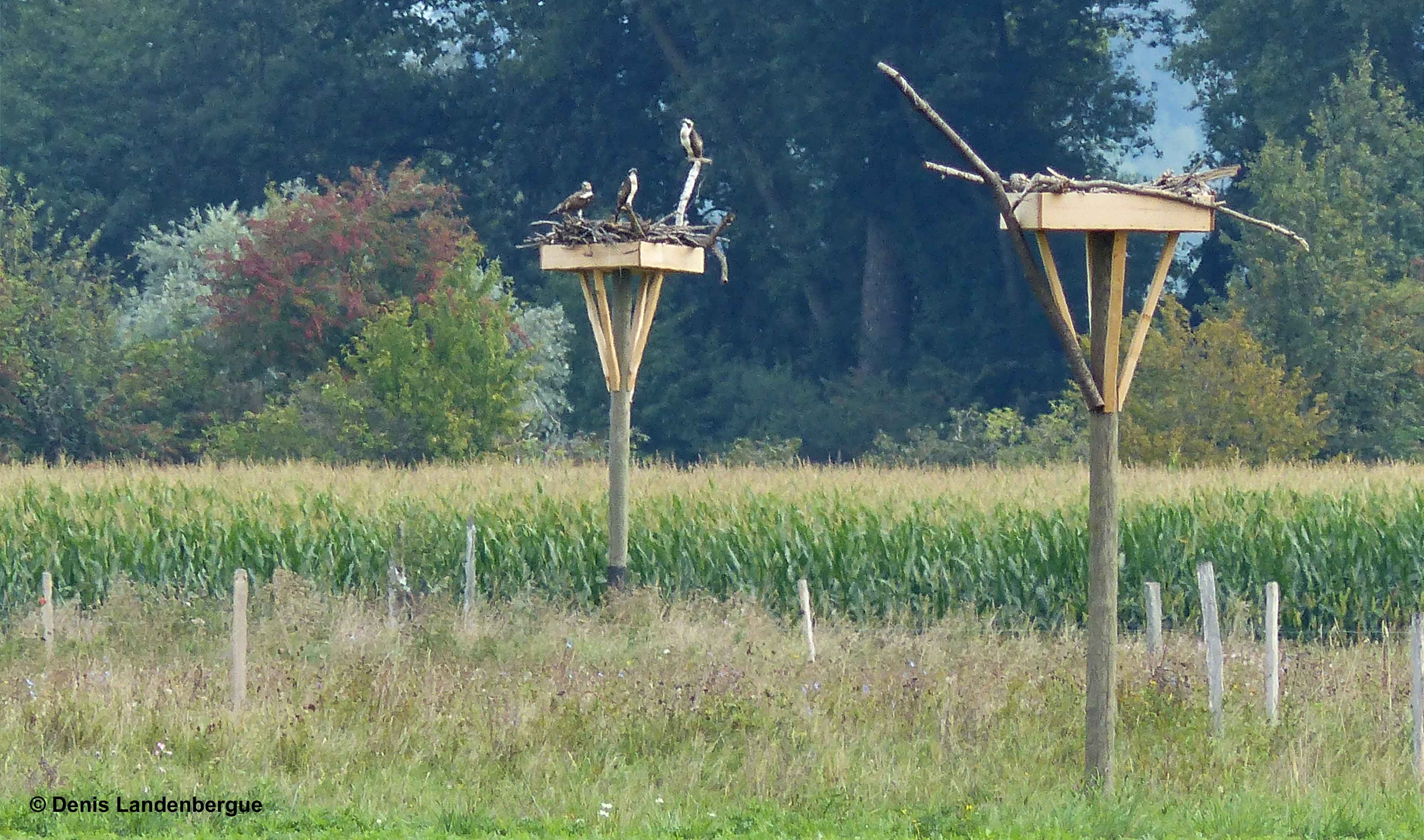 The photo above was taken shortly before PP5 (bird to the left) departed on migration on September 11. We built two nests in front of the aviaries so that the young Ospreys could get used to seeing them. We were delighted when they started to perch on the nests.
The photo above was taken shortly before PP5 (bird to the left) departed on migration on September 11. We built two nests in front of the aviaries so that the young Ospreys could get used to seeing them. We were delighted when they started to perch on the nests.
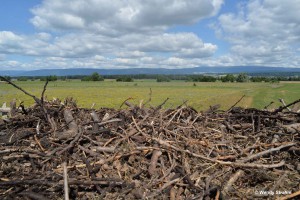
In the wild Osprey nests are of course much larger and with many more branches than these. However, we built these nests during the peak of the July 2015 heatwave, which limited how much work we could do. We will do better for 2016!
Thanks go to Michel Beaud and Pascal Rapin for their help in building these nests with Wendy Strahm and Denis Landenbergue, as well as to the Etablissements de Bellechasse who built and installed the platforms.
Our first young Ospreys take flight
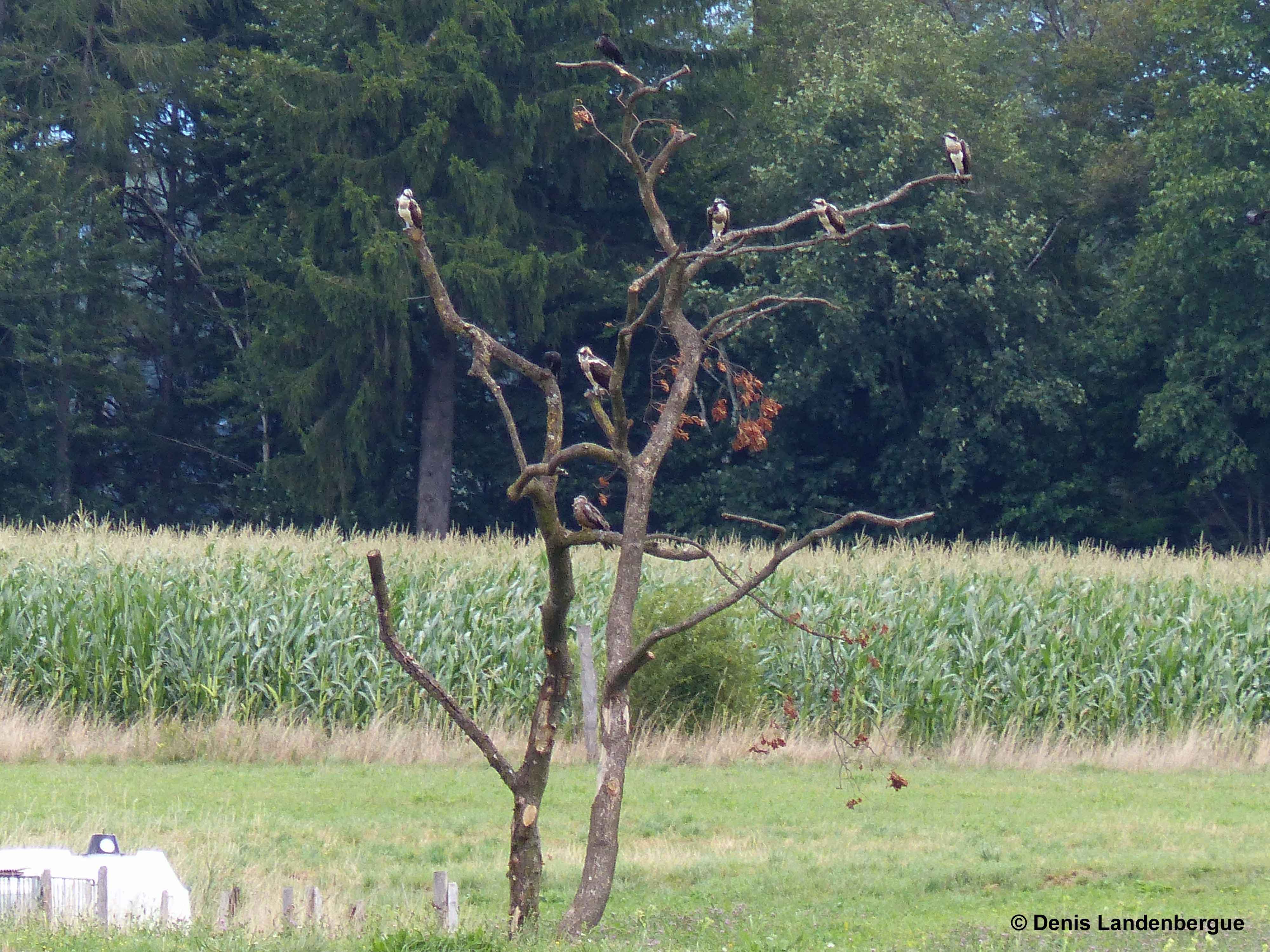 On August 8 and 11 we released our six Ospreys that had been cared for around the clock inside the specially built aviaries. Some, like PP6, took an hour to realise they were free before making their first flight, while others were content to sit inside the aviary for almost the entire day before taking the big step, or should we say jump. For example, we had begun to think that PP4 would never leave until at 18:30 he suddenly made a perfect take-off, spiralling high in the sky before making a fine landing on top of the aviary. It was as if he had been considering his first flight for the entire day and was determined to make a good job of it. The birds are now being fed twice a day, with fish being put out for them once before dawn, and then once in the afternoon. They are very susceptible to disturbance so the project team is watching them non-stop. It is very important that they are not frightened by anything and that they remain in the release area. Three dead trees were “planted” in front of the aviary and above is a unique photo when we had five young altogether, perched on two of the dead trees.
On August 8 and 11 we released our six Ospreys that had been cared for around the clock inside the specially built aviaries. Some, like PP6, took an hour to realise they were free before making their first flight, while others were content to sit inside the aviary for almost the entire day before taking the big step, or should we say jump. For example, we had begun to think that PP4 would never leave until at 18:30 he suddenly made a perfect take-off, spiralling high in the sky before making a fine landing on top of the aviary. It was as if he had been considering his first flight for the entire day and was determined to make a good job of it. The birds are now being fed twice a day, with fish being put out for them once before dawn, and then once in the afternoon. They are very susceptible to disturbance so the project team is watching them non-stop. It is very important that they are not frightened by anything and that they remain in the release area. Three dead trees were “planted” in front of the aviary and above is a unique photo when we had five young altogether, perched on two of the dead trees.
How we identify our birds
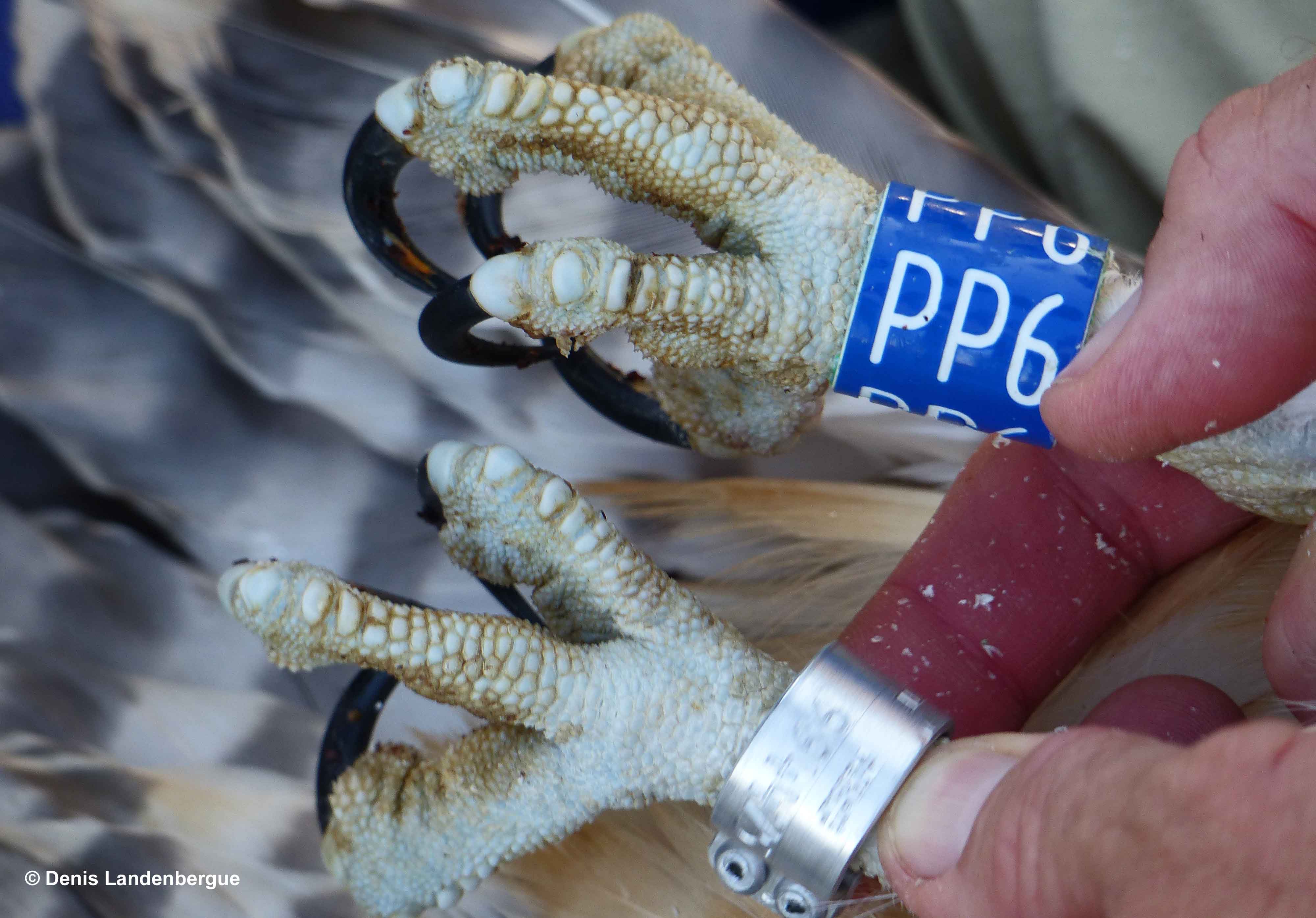 Each bird has a metal ring on the left leg and a plastic colour ring on the right leg. The rings do not hurt the birds nor do they worry them in any way. Rings are only allowed to be put on birds by licensed ringers, which for our project are Michel Beaud, Adrian Aebischer and Roy Dennis. The metal ring on the left leg is provided by the Swiss Ornithological Station (SOS) at Sempach and has a unique number. If someone finds a ringed bird they can inform the SOS who will then tell us that someone has seen the bird.
Each bird has a metal ring on the left leg and a plastic colour ring on the right leg. The rings do not hurt the birds nor do they worry them in any way. Rings are only allowed to be put on birds by licensed ringers, which for our project are Michel Beaud, Adrian Aebischer and Roy Dennis. The metal ring on the left leg is provided by the Swiss Ornithological Station (SOS) at Sempach and has a unique number. If someone finds a ringed bird they can inform the SOS who will then tell us that someone has seen the bird.

To be able to read the metal ring you usually need to have captured the bird. However, on the right leg we put a larger plastic colour ring which can be read more easily when the bird if flying or perched, usually with a telescope or a telephoto camera lens. Each bird has a unique code and in 2015 we put blue rings with the white letters PP followed by a number (PP1, PP2, up to PP6) on the right leg. These rings were already placed on the birds in Scotland so that they were identifiable when they were brought into Switzerland, and the numbers were included on their CITES export and import permits.
Note that blue colour rings are also used for Ospreys in the UK, but these have different combinations of letters and numbers and are placed on the left leg. Therefore, if anyone sees an Osprey with a blue ring on its right leg, it is an Osprey that has been reintroduced to Switzerland. The birds are named after the letters and numbers on their blue plastic ring.
Our young Ospreys have arrived
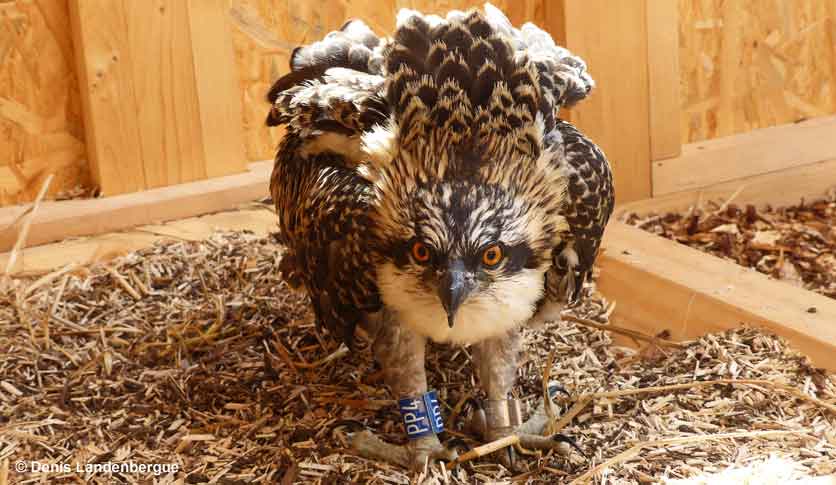
On July 14, 2015, our first six young Ospreys from Scotland arrived at Geneva airport, Continue reading Our young Ospreys have arrived





